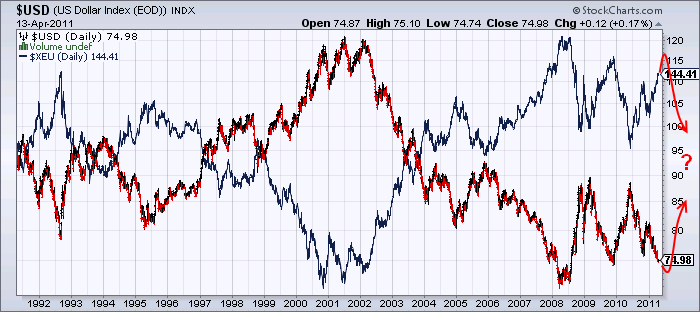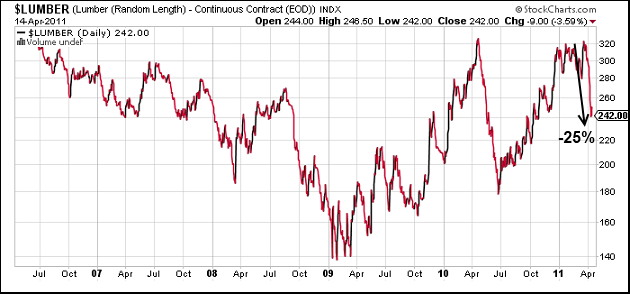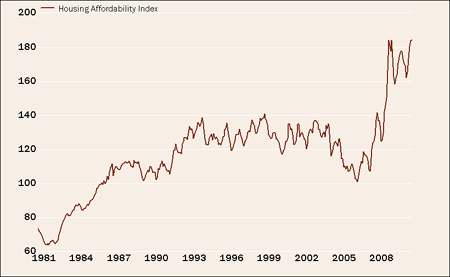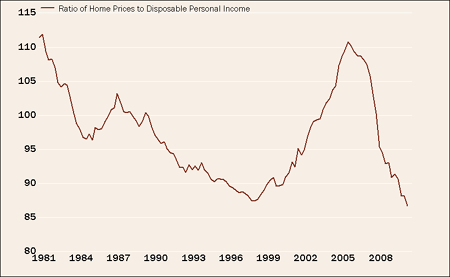1) How will we know when the QE2 trade is over?
It’s about that time when the smart money is beginning to think 10 moves ahead in the chess game. And in this game, the only piece worth focusing on is QE2. QE2 ends on June 30th and traders are already jockeying for position. How soon will the QE2 trade end? No one can tell. It could be a sell in May or it could be a sell the news. But one thing will be very clear when it occurs – the US dollar will stage a counter-trend rally.
One of the primary fuels during this speculative fervor has been the decline of the dollar. With the exception of a brief period in November no sector has benefited more than commodities. As I’ve previously discussed, this hasn’t generated some great economic benefit for the United States (that wasn’t already occurring), but it most certainly has translated into speculative behavior.
The dollar’s decline was relatively benign until the ECB began forecasting rate hikes earlier this year. And the usual inverse correlation can be seen in a sizable Euro rally. The end of QE2 will be seen as a pseudo form of tightening and a step in the direction towards US rate hikes. This could be an excuse for short covering and a USD rally. And while that doesn’t necessarily mean the commodity bull market is over it is likely to put a dent in the QE2 trade.

When currencies converge?
When will it happen? As I mentioned above, the timing is impossible to know, but if I had to venture a guess I’d say we’re closer to a EUR/USD bend in the trend as opposed to a continuation of the trend. And we all know what they say about the trend and friends….
2) Collapsing lumber prices portend a weaker economy?
Did you completely miss the utter collapse in lumber futures in recent weeks? I certainly did. In just the last 3 weeks lumber futures have fallen 25%. The Wall Street Journal says the decline has been due to a number of factors including fears of slowing Asian demand, weak US housing markets and excess supply:
“The recent decline in lumber futures was blamed on increased first-quarter mill production that met stagnant domestic demand and exports that were strangled by shipping bottlenecks.
China emerged last year as a dominant buyer in western U.S. and Canadian lumber markets. Mills responded by ramping up production to meet export demand and take advantage of an expected seasonal surge in U.S. house construction as spring arrived. Yet shippers couldn’t keep up with export sales to China and the spring housing demand failed to materialize, creating an oversupply problem that fueled the selloff, which started late last month.
…Despite the growth in Chinese demand, the U.S. remains the top market for North American lumber, so when the U.S. housing market is dormant, lumber futures prices soften, said Jamie Greenough, a broker and lumber market analyst at Global Securities Corp., a securities and commodities brokerage in Vancouver, B.C.”
Lumber prices have had a very close correlation with the US economy. While prices appear to have stabilized in recent days you have to wonder if this isn’t a sign of more serious weakness overall. One thing is for certain – the US housing market remains mired in a deep recession.

3) Why does the cost of a house get such a bum rap?
Whenever I talk to someone about inflation in the current environment and I tell them housing costs are near their lows they always reply: “sure, but I don’t buy a house every month”. Well, that might be true, but most Americans pay their mortgage every month – so you kind of do buy a house every minute of every day if you think of it in terms of the duration of the loan. Unless you paid in full upfront (which most homeowners don’t) you’re in a persistent state of buying the home. You could actually argue that you buy your home more often than you buy anything else because you can be damn sure the bank is calculating their loan value by the millisecond. Okay, that’s an exaggeration, but why do people downplay their largest monthly expense?
With interest rates near all-time lows mortgage refinancing is very beneficial – even after the recent rally in rates. In addition, new buyers are swooping in at a 30% discount in the real estate market. In essence, homeowners are able to lock-in deflationary prices in the current environment. That’s a significant price decrease for a vast majority of Americans. While many other prices are rising, housing has rarely been more affordable. Some recent charts from Liz Ann Sonders at Charles Schwab put this into perspective:

It’s no coincidence that the Housing Affordability Index troughed with inflation in the 70′s!

Inflation?
The moral is, the cost of owning a home has plummeted in recent years and this accounts for the majority of one’s monthly non-discretionary spending! Whether you are looking to purchase a home or have an old mortgage you are able to take advantage of significant deflation in your largest monthly expense. This isn’t an attempt to downplay the damaging impact of inflation in other markets, however, when assessing the bigger picture it is very important that we keep things in perspective. According to the BLS, housing related expenditures account for 47% of total consumer expenditures. The price you see on the gas sign every day isn’t nearly as important as the one you see on your monthly mortgage statement. And there is absolutely zero inflation in that payment.
No comments:
Post a Comment